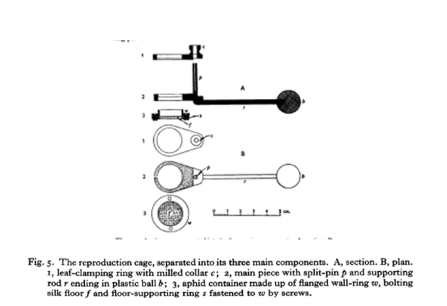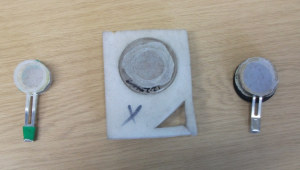Mention clip cage to an aphidologist and the chances are that they will smile and begin reminiscing about the days when they had to sit down and spend hours refurbishing and making new ones; if they were lucky enough to be in a big research group as I was, they will have had the fun of the communal clip cage renovation day, otherwise they will have laboured doggedly away on their own. Mention clip cage to an entomologist and they may have heard of them, but probably not used them; to a non-entomologist you will be talking gibberish. In fact, this week at the beginning of a lecture to the MSc Entomology course here at Harper Adams, I held a clip cage in the air and asked those who knew what it was to put their hands in the air, less than a third were willing to hazard a guess. For those of you who don’t know the answer, clip cages were invented, or at least revealed in the scientific literature by two Canadian entomologists MacGillivray & Anderson in 1957. Their purpose, to keep aphids confined individually to leaves of a plant in a simple and effective way.
Before this aphidologists generally used to confine them in large cages covering whole plants, (Davidson, 1925; Kennedy & Booth, 1950). This allowed the aphids to select their own feeding sites but which of course made knowing what an individual aphid was doing in terms of longevity and fecundity quite difficult. Kennedy & Booth (1950) were very much aware of this and attempted to solve the problem by using this using this rather over-engineered reproduction cage
This cage, although doing the job was difficult to make and also required a somewhat complicated method of attachment to the plant so as not to pull the leaves off, hence the birth of the
MacGillivray and Anderson clip cage. In 1958 another Canadian entomologist Noble described a variant on the MacGillivray & Anderson version where instead of a muslin lid, a cork was used , the theory being that you didn’t need to open the clip to check what the aphid was doing and risk it falling off the leaf, something aphids seem to delight in doing , especially when you are six
days into obtaining seven-day fecundity readings! Incidentally, this version of the clip cage has resulted in one of my favourite bug-bears, as many people tend to cite Noble (1958) when referring to clip cages, that is if they actually remember to cite anyone at all, and of course they are using the MacGillivray & Anderson version.
Since then the humble clip cage has become the standard way for aphidologists to keep aphids on single leaves of their hosts plants. They have also been used to confine young Lepidopteran larvae to leaves (Moore et al, 2003) but due to the frass production of lepidopteran larvae are better suited to aphids whose honeydew causes less of a problem for cage cleanliness. They are very versatile and can be made in different sizes to suit the host plant. All you need are hair clips, Perspex tubing and the wherewithal to cut it to the right size, some foam or sponge, fine muslin or similar textile and a waterproof adhesive.
Clip cages are not perfect. There are some drawbacks; for example, if you don’t move them slightly every day the leaves can develop chlorosis which of course will change the performance of the aphids and there is some evidence that the leaf can suffer some physical damage (Moore et al, 2003) and that even if you do move the cages the aphids can behave slightly differently than those in whole plant cages (Awmack & Leather (2007), but as long you are aware of the possible drawbacks clip cages remain an indispensable tool for those wishing to study single aphids on whole plants.
And of course, there is the immense satisfaction and sense of achievement of being able to make your own equipment relatively simply and inexpensively. That said, I certainly received some strange looks when I was working in Finland and found that there were no clip cages in the lab and had to attempt to buy hair clips in down-town Helsinki.
Awmack, C. S. & Leather, S. R. (2007).Growth and development. In Aphids as Crop Pests, 135-151 (Eds H. F. Van Emden and R. Harrington). Wallingford: CABI.
Davidson, J. (1925) Biological studies of Aphis ruimicis Linn. factors affecting the infestation of Vicia faba with Aphis rumicis. Annals of Applied Biology, 12, 472-507
Evans, A.C. (1938) Physiological relationships between insects and their host plants I. The effect of the chemical composition of the plant on reproduction and production of winged forms in Brevicoryne brassicae L. (Aphididae). Annals of Applied Biology, 25, 558-572
Kennedy, J.S. & Booth, C.O. (1950) Methods for mass rearing and investigating the host relations of Aphis fabae Scop. Annals of Applied Biology, 37, 451-470
MacGillivray, M. E. &Anderson, G. B. (1957). Three useful insect cages. Canadian Entomologist 89: 43-46.
Noble, M. D. (1958). A simplified clip cage for aphid investigations. Canadian Entomologist 90, 60.
Moore, J.P., a, J.E., Paul, N.D. & Whittaker, J.B. ( 2003) The use of clip cages to restrain insects reduces leaf expansion systemically in Rumex obtusifolius Ecological Entomology, 28, 239-242







It is such a fantastically simple idea!
LikeLike
Thanks for this article. It’s perfect timing for a student of mine who wants to work with live aphids (never really done that myself!).
LikeLike
happy to help
Professor Simon R Leather BSc PhD CBiol FRES
Professor of Entomology
Department of Crop and Environment Sciences
Harper Adams University
Edgmond
Newport
Shropshire
UK
TF10 8NB
++(0) 1952-815488
simonleather@harper-adams.ac.uk
Twitter: @Entoprof
LikeLike
I am really interested on using them for some experiments, but I could only find few websites to order them, and not the ones I was most interested in… any suggestions?
LikeLike
We make our own – it is quite simple and that way you can be sure that they are fit for purpose
LikeLike
I need clip cage for my research where can I
buy??/
LikeLike
As far as I know you can’t buy them – we make our own
LikeLike
Hi- this has been super useful. We’re hoping to test host use of aphids and the clip cages you can buy just having been working for us. A question about this, though: we’ve been using a pipe cutter to cut pvc pipe to size, but it shatters the perspex tubing. What do you recommend to use to cut it?
Thanks again for this!
Gwendolyn
(Ms Student, Auburn University)
LikeLike
We use a hacksaw which works just fine
LikeLike